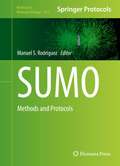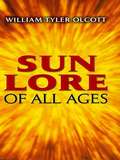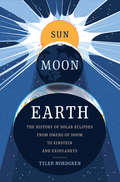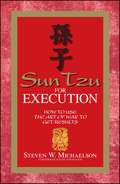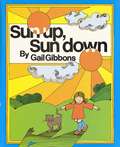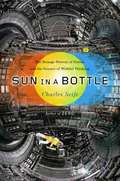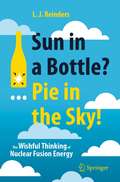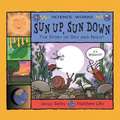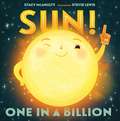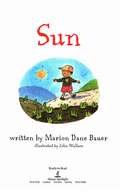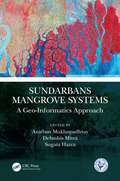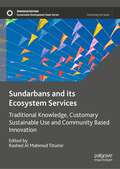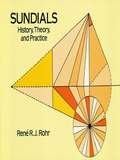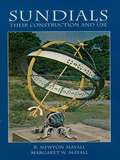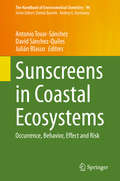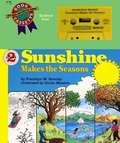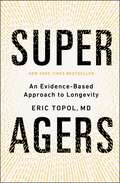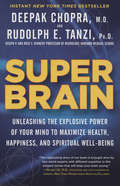- Table View
- List View
Summertime Sleepers: Animals That Estivate
by Melissa Stewart Sarah BrannenA 2022 Robert F. Sibert Honor BookEveryone knows about animals that hibernate in the winter. But it's time to discover animals that sleep all summer long! <p><p>All science classrooms discuss animals that hibernate during winter months, but few know about animals that estivate—a prolonged sleep during hot or dry periods. Dual layers of text awaken readers to the reasons estivating animals become dormant—whether it's because warm weather threatens food supply or to avoid increased body temperatures. From the ladybug to the salamander, from the lungfish to the desert hedgehog, twelve estivating animals and their habits—both when sleeping and awake—are explained through clear text and elegant watercolor illustrations that create a scrapbook feel. <P><P><i>Advisory: Bookshare has learned that this book offers only partial accessibility. We have kept it in the collection because it is useful for some of our members. Benetech is actively working on projects to improve accessibility issues such as these.</i>
Sumo
by Manuel S. RodriguezThis volume explores various methodologies to study biochemical, molecular, and cellular biology aspects of some processes regulated by protein SUMOylation. SUMO: Methods and Protocols is organized into four parts, and starts with an historical overview on protein SUMOylation and a presentation of the methods included in the book. The first part also includes a review on chromatin regulation by dynamic SUMO modifications. The second part focuses on in vitro techniques, including biochemical methods to study mechanistic aspects of protein SUMOylation. The third part includes protocols to be used with cell cultures, which often are the first approaches used in most laboratories. The final part includes methodologies adapted for the analysis in vivo using distinct model organisms. Written in the highly successful Methods in Molecular Biology series format, chapters include a brief introduction to the subject, a list of necessary materials and reagents, a step-by-step reproducible laboratory protocol ending with a Notes section on troubleshooting tips, and tips and strategies to avoid known pitfalls. Unique and cutting-edge, SUMO: Methods and Protocols provides a comprehensive source of protocols for specialists and researchers not familiar with this vital system.
Sun Lore of All Ages: A Collection of Myths and Legends
by William Tyler OlcottFrom the ruins of Greek and Roman temples to Mexico's Pyramid of the Sun and the enduring mysteries of Stonehenge, this captivating study circles the earth in its examination of the legends, traditions, and superstitions that all cultures have woven about the sun. Starting with solar creation myths, this volume explores ancient ideology surrounding the sun and moon, solar mythology, and solar folklore. An extended analysis of sun worship around the world leads to accounts of sun-catcher myths and solar festivals. Solar omens, traditions, and superstitions are discussed at length, along with the solar significance of burial customs and emblematic and symbolic forms of the sun. The book concludes with a look at the sun in light of scientific discovery. 30 evocative illustrations complement the text.
Sun Moon Earth: The History of Solar Eclipses from Omens of Doom to Einstein and Exoplanets
by Tyler NordgrenOne of Amazon's Best Science Books of 2016An astronomer traces the natural history of solar eclipses from supernatural to scientific phenomenon, showing us a more wonderful way to look up at the skyOn August 21, 2017, more than ten million Americans will experience an awe-inspiring phenomenon: the first total eclipse of the sun in America in almost forty years. In Sun Moon Earth, astronomer Tyler Nordgren illustrates how this most seemingly unnatural of natural phenomena was transformed from a fearsome omen to a tourist attraction. From the astrologers of ancient China and Babylon to the high priests of the Maya, Sun Moon Earth takes us around the world to show how different cultures interpreted these dramatic events. Greek philosophers discovered eclipses' cause and used them to measure their world and the cosmos beyond. Victorian-era scientists mounted eclipse expeditions during the age of globe-spanning empires. And modern-day physicists continue to use eclipses to confirm Einstein's theory of relativity.Beautifully illustrated and lyrically written, Sun Moon Earth is the ideal guide for all eclipse watchers and star gazers alike.
Sun Tzu For Execution: How to Use the Art of War to Get Results
by Steven W MichaelsonA Simon & Schuster eBook. Simon & Schuster has a great book for every reader.
Sun Up Sun Down (Fountas & Pinnell LLI Blue #Level M)
by Gail GibbonsDescribes the characteristics of the sun and the ways in which it regulates life on earth.
Sun in a Bottle
by Charles SeifeWhen weapons builders detonated the first hydrogen bomb in 1952, they tapped into the biggest source of energy in our solar system - the phenomenon that makes the sun shine. Nuclear fusion seems a virtually unlimited source of power, but it has been at the center of a tragic and comic pursuit that has left scores of scientists battered and disgraced. Like the eternal quest to build a perpetual motion machine, the dream of harnessing the energy of a miniature star is irresistible. Not only would a fusion energy device give the world endless electrical power, it would give power to its inventors - financial power, the power of fame, even military might. Right now the world's richest countries are spending billions of dollars trying to build a giant fusion reactor. Yet if history is any guide, the money will not bring the dream of fusion energy within reach. Indeed, the quest for fusion energy has been a failure, generation after generation. Fusion is at the heart of some of the biggest scientific scandals of all time, and Charles Seife traces its story from its beginning into the twenty-first century. Even after fusion scientists face defeat after defeat, they continue trying to put the sun in a bottle, hoping against hope that they will succeed where others have failed. The science of wishful thinking is as strong as ever, and this book is our key to understanding why.
Sun in a Bottle?... Pie in the Sky!: The Wishful Thinking of Nuclear Fusion Energy
by L. J. ReindersThis book gives an accessible overview of the 70-year history of nuclear fusion research and the vain attempts to construct an energy-generating nuclear fusion reactor. It shows that even in the most optimistic scenario nuclear fusion, despite the claims of its proponents and the billions being spent on research, will not be able to make a sizable contribution to the energy mix in this century. The important consequence is that nuclear fusion will not be a factor in combating climate change, since the race for carbon-free energy will have been won or lost long before the first nuclear fusion power station comes on line.
Sun up, Sun down: The Story of Day and Night (Science Works)
by Jacqui BaileyFollows the sun from dawn to dusk to explain how light rays travel, how shadows are formed, how the moon lights up the night sky, and more.
Sun! One in a Billion (Our Universe #2)
by Stacy McAnultyFrom the author of Earth! My First 4.54 Billion Years comes a new picture book about space—this time starring our Sun!Meet Sun: He's a star! And not just any star—he's one in a billion. He lights up our solar system and makes life possible. With characteristic humor and charm, Stacy McAnulty channels the voice of Sun in this next celestial "autobiography." Rich with kid-friendly facts and beautifully illustrated, Sun! One in a Billion is an equally charming and irresistible companion to Earth! My First 4.54 Billion Years.
Sun, Moon, and Planets
by Lawrence Hall of Science University of California at BerkeleyNIMAC-sourced textbook
Sun, Moon, and Stars
by Lawrence Hall of Science University of California at BerkeleyNIMAC-sourced textbook
Sun: Ready-to-read Level 1 (Weather Ready-to-reads Ser.)
by Marion Dane BauerThis book reveals certain facts about the sun and describes why sun is vital to life.
Sundarbans Mangrove Systems: A Geo-Informatics Approach
by Anirban Mukhopadhyay Debashis Mitra Sugata HazraSundarbans, a UNESCO heritage site, is the world’s largest single chunk of mangroves distributed on the Indian and Bangladesh coasts. The mangroves and associated ecosystems are one of the most fertile ecosystems of the earth. Sundarbans Mangrove Systems: A Geo-Informatics Approach portrays different perspectives of studying Sundarbans and mangroves using geospatial analysis. This book highlights the major issues with the Sundarbans mangrove forest, its future conservation strategies and its ecological importance using geo-informatics technology. It explains the usage of remote sensing data for providing information about the present state of mangroves and their tropic status, including assessment in terms of extent, density of community, condition, diversity, identifying potential habitats and heterogeneity. Furthermore, it discusses the use of hyperspectral remote sensing data for species level classification of mangroves, community zonation for biodiversity assessment and for preparing management plans for conservation. KEY FEATURES Exclusively covers the ecological state of Sundarbans (mangrove systems) through geo-informatic studies Describes the application of a combination of geomorphological, biogeochemical and remote sensing methods to the analysis of temporal changes Includes environmental factors affecting the health and decline of mangroves Covers biodiversity and ecological controls in mangroves ecosystems Discusses a remote sensing approach for tropical forested island and mangroves mapping This book is aimed at graduate students and researchers in environmental sciences, ecology, marine sciences, biology, geosciences and GIS/remote sensing areas.
Sundarbans and its Ecosystem Services: Traditional Knowledge, Customary Sustainable Use and Community Based Innovation (Sustainable Development Goals Series)
by Rashed Al Mahmud TitumirThis edited volume focuses on the largest single tract contiguous mangrove forest in the world— the Sundarbans— exploring traditional knowledge, customary sustainable use and community-based innovation. The book analyses the current state of the Sundarbans, its multiple values and ecosystem services, to demonstrate that Indigenous and local knowledge (ILK) is essential for the conservation and sustainable use of natural resources. Not only does this play an integral role in realising SDG 14 (life below water) and SDG 15 (life on land), it also actively contributes towards achieving many other goals and targets. It contributes a new understanding of sustainability by bringing human-nature relationships in view of the renewed interest in biodiversity and climate change— heightened by the COVID-19 pandemic. The book links scientific knowledge with multi, inter, trans- disciplinary nature of ILK for sustainable development collected from the ground. It challenges the market-based approach in valuing the natural resources, and demonstrates that the valuation of environmental resources through market penetration pricing does not reckon the social benefits and values coproduced through complementarity between humans and nature.
Sundials: History, Theory, and Practice
by René R.J. Rohr"His lively pen, his direct and simple style, his expressive vocabulary, his avoidance of pedantry, his conciseness in the exposition of his thoughts make his book a pleasure to read." -- Henri Michel, International Academy of the History of ScienceThe story of man's efforts to measure time is a long one -- reaching back thousands of years to the dawn of civilization. Among the earliest instruments developed for telling time was the sundial. In this expert study, a noted sundial expert offers a fascinating and informative account of these ancient devices, presented in simple, lively language.Over the centuries, many different varieties of sundials have been constructed, and Mr. Rohr provides detailed, accurate descriptions of them all: classical sundials, inclined dials, solar calendars, analemmatic dials, moon dials, and many more. There is even a chapter devoted to especially remarkable dials past and present, and a listing of the most popular sundial mottoes. In this profusely illustrated volume, you will not only learn about the long and colorful history of the sundial, you will learn a practical method of building one yourself. No special knowledge is required, other than an understanding of the basic principles of cosmography and of the relative movements of the sun and the planets. (These are recalled in an elementary way in a special chapter.) For mathematically inclined readers, more complex formulae and calculations have been included, some of which have never been printed in a book of gnomonics.
Sundials: Their Construction and Use
by R. Newton Mayall Margaret W. MayallTo many people, the construction of a sundial implies laborious mathematical calculations and a knowledge of astronomy. Nothing could be farther from the truth. This fascinating handbook, used in conjunction with ordinary tools and materials found around the home, makes it easy to design and construct a sundial on almost any surface and in virtually any position. Introductory chapters offer a wealth of information on the sundial's development from ancient times to the present, why the sundial tells time, how to design and make a dial, and more. These chapters are followed by full instructions on how to construct the hour lines for many kinds of sundials, by the graphic or geometric method. The use of this method doesn't require a knowledge of mathematics or astronomy. It simplicity and accuracy, together with the ease and quickness of delineation, make it very practical. Readers will also find fascinating chapters on dial furniture, portable sundials, constructing a heliochronometer (a highly precise solar timekeeper), sundial classification, and other topics. Accompanying the text are 150 well-chosen illustrations, many published for the first time. They depict scale models, as well as a moon dial, a cathedral dial, and other actual dials from around the world, including the world's largest, in Jaipur, India. If you've ever wanted to build your own sundial, or if you simply want to know more about these ancient timepieces that can show the time of day as accurately as many clocks, this clearly written, easy-to-follow guide is "the best book available." -- Commonweal.
Sundials: Their Theory and Construction
by Albert WaughHave you every wanted to build a sundial or to understand how one works? Then you have probably been frustrated as you search vainly for help. Most books on the subject are either rare out-of-print works published centuries ago and available only in highly specialized collections, or highly complicated treatises whose information is hidden behind frightening arrays of involved formulas. But now your search is over. This book is designed to meet sundialing needs at either the simple or the sophisticated level. Albert E. Waugh, professor and administrator at the University of Connecticut for 40 years, and an expert on the subject of sundials and their curious history, presents, on the one hand, a rigorous appraisal of the science of sundials, including mathematical treatment and an explanation of the pertinent astronomical background; on the other hand, he presents simple and non-technical treatments such that several of the dials can be built by children!The subject matter is arranged in 19 chapters, each covering a different aspect of dialing science. All the common types of dials are covered, but the reader can also learn about analemmatic dials, polar dials, equatorial dials, portable dials, memorial dials, armillary spheres, reflected ceiling dials, cross dials, and old-fashioned noon marks. There are also sections on dial furniture, mottoes, the actual layout out of a dial, the equation of time, finding time in other cities, how to find the meridian, how to find time by moonlight -- even how to estimate time from the length of one's own shadow! Directions are given for designing dials for any part of the country, or any place in the world. The author has designed many dials, and his text is filled with helpful hints based on his own personal experience. There are over 100 illustrations, charts, and tables, followed by an appendix which is filled with material which reduces or eliminates the need for calculation on the part of the reader.
Sunflower Life Cycle
by Jeff BauerLearn more about how plants grow with this great book about sunflowers.
Sunscreens in Coastal Ecosystems: Occurrence, Behavior, Effect and Risk (The Handbook of Environmental Chemistry #94)
by Julián Blasco Antonio Tovar-Sánchez David Sánchez-QuilesThis book provides a comprehensive and authoritative review of the chemical analysis of UV filters in coastal waters and their impact on the marine environment. The sun care is today the most important sector within the cosmetics industry, with annual increases in sales. The main components of sunscreens, organic and inorganic UV filters, have been detected in many coastal regions, with the highest concentrations in coastal areas under high anthropogenic pressure. Moreover, these compounds have been found to be bioaccumulated in aquatic biota causing biological and toxicological responses; some organic UV filters act as endocrine disruptors in aquatic biota, affecting survival, behavior, growth, development and reproduction. On the other hand, inorganic UV filters, mainly based on nanoparticles, have been demonstrated to have various impacts on marine organisms, such as inducing oxidative stress in abalones, accumulating in microalgae, affecting the immune response in mussels, bleaching corals, and genotoxicity in fish, among others. All these effects of sunscreens on the marine environment highlight the need for more stringent and environmentally friendly regulations. This book covers the latest analytical methodologies used in assessing the impact of UV filters impact on marine waters, especially on marine biota, and also critiques the global regulation of UV filters and the environmental risk of using sunscreens. Featuring specific case studies of the environmental effects of sunscreens in the Mediterranean Sea and Hawaii, which highlight the importance of balancing human health with environmental health of coastal ecosystems, it will appeal not only to scientists and students from various disciplines (environmental chemistry, biology, ecology, biogeochemistry, fisheries and climate change among others), but also to environmental managers wanting to promote new restrictive regulations on the use of UV filters, and to professionals from the cosmetic industry interested in the development of eco-friendly sunscreens.
Sunshine Makes the Seasons
by Giulio Maestro Franklyn M. BranleyNow reillustrated with colorful, kid-friendly art, this book explains to young readers how the sun makes the seasons and how its light affects life on the earth for all living things. Image descriptions present.
Sunshine Makes the Seasons
by Giulio Maestro Franklyn M. BranleyNow reillustrated with colorful, kid-friendly art, this book explains to young readers how the sun makes the seasons and how its light affects life on the earth for all living things.
Super Agers: An Evidence-Based Approach to Longevity
by Eric TopolSuper Agers is a detailed guide to a revolution transforming human longevity. This is a breakthrough moment in the history of human health care. The person making that bold claim is one of the most respected medical researchers in the world, Eric Topol. Dr. Topol&’s unprecedented, evidenced-based guide is about how you and your family and friends can benefit from new treatments coming available at a faster rate than ever. From his unique position as a leader overseeing millions in research funding, Dr. Topol also explains the fundamental reasons—from semaglutides to AI—that we can be confident these breakthroughs will continue. Ninety-five percent of Americans over sixty have at least one chronic disease and almost as many have two. That is the essential problem this revolution is solving. He explains the power of the new approaches to the worst chronic killers—diabetes/obesity, heart disease, cancer, and neurodegeneration—and how treatments can begin long before middle age, and even long after. In thirty years, we will have five times as many people at least one hundred years old and they will be healthier than ever because of the breakthroughs Dr. Topol describes. The amazing discoveries Topol brings into sharp focus are deeply inspiring about our human potential. We can now realistically see how we can make considerable headway for preventing age-related diseases and may one day be able to slow the body-wide aging process itself.
Super Brain
by Deepak Chopra Rudolph E. TanziA manual for relating to the brain in a revolutionary new way, Super Brain shows you how to use your brain as a gateway for achieving health, happiness, and spiritual growth. The authors are two pioneers: bestselling author and physician Deepak Chopra and Harvard Medical School professor Rudolph E. Tanzi, one of the world's foremost experts on the causes of Alzheimer's. They have merged their wisdom and expertise for a bold new understanding of the "three-pound universe" and its untapped potential.In contrast to the "baseline brain" that fulfills the tasks of everyday life, Chopra and Tanzi propose that, through a person's increased self-awareness and conscious intention, the brain can be taught to reach far beyond its present limitations. "We are living in a golden age for brain research, but is this a golden age for your brain?" they ask. Super Brain explains how it can be, by combining cutting-edge research and spiritual insights, demolishing the five most widespread myths about the brain that limit your potential, and then showing you methods to:-Use your brain instead of letting it use you-Create the ideal lifestyle for a healthy brain-Reduce the risks of aging-Promote happiness and well-being through the mind-body connection-Access the enlightened brain, the gateway to freedom and bliss-Overcome the most common challenges, such as memory loss, depression, anxiety, and obesity Your brain is capable of incredible healing and constant reshaping. Through a new relationship with your brain you can transform your life. In Super Brain, Chopra and Tanzi guide you on a fascinating journey that envisions a leap in human evolution. The brain is not just the greatest gift that Nature has given us. It's the gateway to an unlimited future that you can begin to live today.

